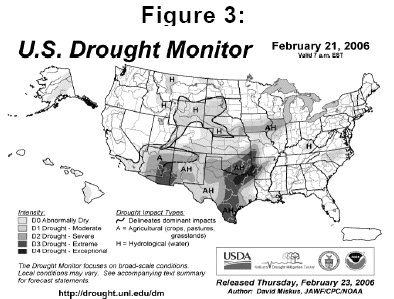Vol. 22, Issue 03, February 23, 2006
Jose G. Peña
Extension Economist-Management
US. Cattle Inventory Up 1.7%; Market Outlook Bright
The U.S. cattle inventory increased slightly for the second year in a row, confirming the end of an eight year span of a declining cattle herd since the 103.5 million head cyclical peak on January 1, 1996. (See Figure 1). According to USDA’s January 27, 2006 Cattle Report, all cattle and calves in the U.S. as of January 1, 2006 totaled 97.1 million head, up 1.7 percent from 95.438 on January 1, 2005 and up 2.3% from 94.888 million head on January 1, 2004. The report indicated increases in all categories including other heifers (feedlot heifers) which increased very slightly (3,200 head) from an inventory 9.763 million head on January 1, 2005 (see table 1). While the inventory increase was relatively small, the report indicates moderate growth in the cattle inventory. While heifers held for beef cow replacement were up 3.8 and 7.0 percent from 2005 and 2004, respectively, those expected to calve in 2006 were up only 2.2 percent. Beef cows were up one percent and beef cow replacements up only 3.8 percent indicating relatively slow growth.


Market Outlook Bright
There was only minor market reaction as the inventory increase had been anticipated by the industry.
While the cattle market appears flat to slightly weakening during January 2006, overall, the calf and feeder market outlook appears relatively bright. (See Figure 2) The market appears to be reflecting the influence of several factors, including the reopening of the border to Canadian live cattle imports while exports markets to Japan and Korea opened temporarily but re-closed.

Calf Crop Down
Meanwhile calf and feeder cattle supplies remain low. The 2005 calf crop was estimated at 37.78 million head, up slightly (0.7 percent) from 37.505 million calves born in 2004 and down 1.9 percent from a calf crop of 37.903 million head in 2003. Calves born during the first half of the year (spring 2006 feeder calf crop) were estimated at 27.4 million, up just slightly from2004.
Influence of Drought on Herd Rebuilding
The slow inventory increase has been influenced by the continuing drought in the South Central U.S. (see figure 3). This area accounts for approximately 60 percent of the U.S. cattle herd. (See Figure 4). The drought has resulted poor condition of small grain and other winter pastures and reduced the volume of calves retained on small grain pastures. The USDA report reflects a substantially lower number of calves on pasture this winter, compared to a year ago at this same time. It appears that the calves may have gone to feedlots as feedlot placements were up sharply in November and December.
The prolonged drought will no doubt influence the rate of expansion of the national cattle herd. According to the annual report, states that reported some of the largest increases in females are currently states being heavily impacted by the drought. As such, expansion may be occurring even slower than reported.


